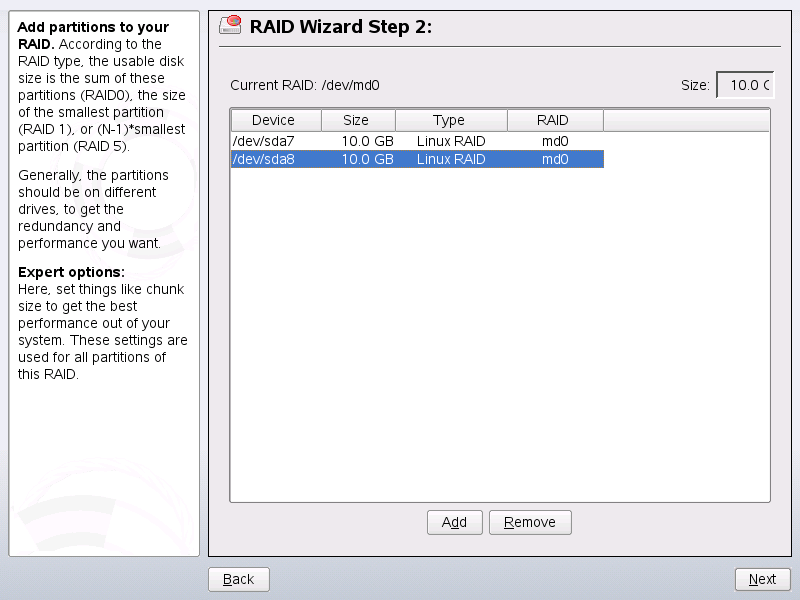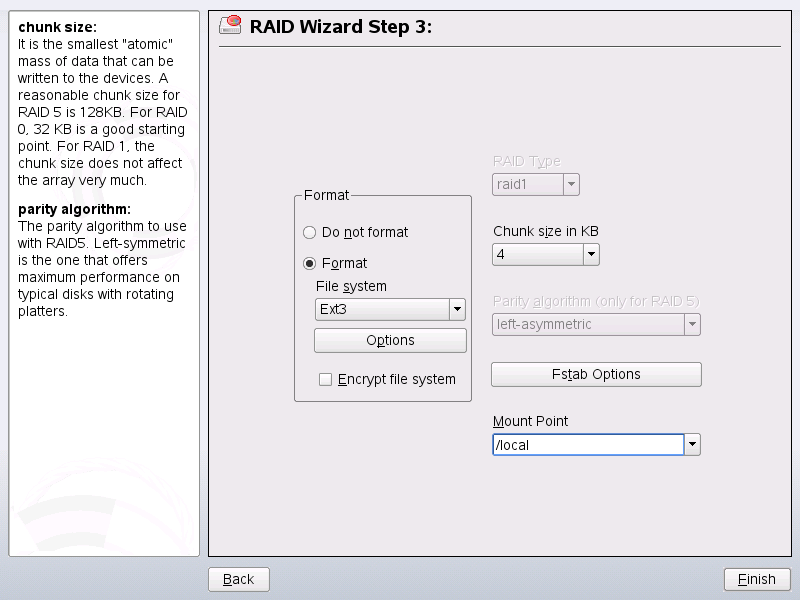2.3 Soft RAID Configuration
The purpose of RAID (redundant array of independent disks) is to combine several hard disk partitions into one large virtual hard disk to optimize performance, data security, or both. Most RAID controllers use the SCSI protocol because it can address a larger number of hard disks in a more effective way than the IDE protocol and is more suitable for parallel processing of commands. There are some RAID controllers that support IDE or SATA hard disks. Soft RAID provides the advantages of RAID systems without the additional cost of hardware RAID controllers. However, this requires some CPU time and has memory requirements that make it unsuitable for real high performance computers.
2.3.1 RAID Levels
openSUSE® offers the option of combining several hard disks into one soft RAID system with the help. RAID implies several strategies for combining several hard disks in a RAID system, each with different goals, advantages, and characteristics. These variations are commonly known as RAID levels.
Common RAID levels are:
- RAID 0
-
This level improves the performance of your data access by spreading out blocks of each file across multiple disk drives. Actually, this is not really a RAID, because it does not provide data backup, but the name RAID 0 for this type of system has become the norm. With RAID 0, two or more hard disks are pooled together. The performance is very good, but the RAID system is destroyed and your data lost if even one hard disk fails.
- RAID 1
-
This level provides adequate security for your data, because the data is copied to another hard disk 1:1. This is known as hard disk mirroring. If a disk is destroyed, a copy of its contents is available on another one. All of them except one could be damaged without endangering your data. However, if damage is not detected, it also may happen that damaged data is mirrored to the correct disk and data corruption happens that way. The writing performance suffers a little in the copying process compared to when using single disk access (10 to 20 % slower), but read access is significantly faster in comparison to any one of the normal physical hard disks, because the data is duplicated so can be parallel scanned. Generally it can be said that Level 1 provides nearly twice the read transaction rate of single disks and almost the same write transaction rate as single disks.
- RAID 2 and RAID 3
-
These are not typical RAID implementations. Level 2 stripes data at the bit level rather than the block level. Level 3 provides byte-level striping with a dedicated parity disk and cannot service simultaneous multiple requests. Both levels are only rarely used.
- RAID 4
-
Level 4 provides block-level striping just like Level 0 combined with a dedicated parity disk. In the case of a data disk failure, the parity data is used to create a replacement disk. However, the parity disk may create a bottleneck for write access. Nevertheless, Level 4 is sometimes used.
- RAID 5
-
RAID 5 is an optimized compromise between Level 0 and Level 1 in terms of performance and redundancy. The hard disk space equals the number of disks used minus one. The data is distributed over the hard disks as with RAID 0. Parity blocks, created on one of the partitions, are there for security reasons. They are linked to each other with XOR, enabling the contents to be reconstructed by the corresponding parity block in case of system failure. With RAID 5, no more than one hard disk can fail at the same time. If one hard disk fails, it must be replaced as soon as possible to avoid the risk of losing data.
- RAID 6
-
To further increase the reliability of the RAID system, it is possible to use RAID 6. In this level, even if two disks fail, the array still can be reconstructed. With RAID 6, at least 4 hard disks are needed to run the array. Note, that when running as software raid, this configuration needs a considerable amount of CPU time and memory.
- Other RAID Levels
-
Several other RAID levels have been developed (RAIDn, RAID 10, RAID 0+1, RAID 30, RAID 50, etc.), some of them being proprietary implementations created by hardware vendors. These levels are not very widespread, so are not explained here.
2.3.2 Soft RAID Configuration with YaST
The YaST soft RAID configuration can be reached from the YaST Expert Partitioner, described in Section 2.1, Using the YaST Partitioner. This partitioning tool enables you to edit and delete existing partitions and create new ones that should be used with soft RAID. There, create RAID partitions by first clicking then selecting as the partition identifier. For RAID 0 and RAID 1, at least two partitions are needed—for RAID 1, usually exactly two and no more. If RAID 5 is used, at least three partitions are required. It is recommended to take only partitions of the same size. The RAID partitions should be stored on different hard disks to decrease the risk of losing data if one is defective (RAID 1 and 5) and to optimize the performance of RAID 0. After creating all the partitions to use with RAID, click to start the RAID configuration.
HINT: Starting with openSUSE 10.2, the system detects the settings of pseudo RAID adapters found on many mainboards. These are used to setup the software RAID without additional interaction.
In the next dialog, choose between RAID levels 0, 1, and 5 (see Section 2.3.1, RAID Levels for details). After
is clicked, the following dialog lists all partitions with
either the Linux RAID
or Linux native
type
(see Figure 2-7). No swap or DOS partitions are
shown. If a partition is already assigned to a RAID volume, the name of the
RAID device (for example, /dev/md0) is shown in the list.
Unassigned partitions are indicated with --
.
Figure 2-7 RAID Partitions

To add a previously unassigned partition to the selected RAID volume, first click the partition then . At this point, the name of the RAID device is entered next to the selected partition. Assign all partitions reserved for RAID. Otherwise, the space on the partition remains unused. After assigning all partitions, click to proceed to the settings dialog where you can fine-tune the performance (see Figure 2-8).
Figure 2-8 File System Settings

As with conventional partitioning, set the file system to use as well as encryption and the mount point for the RAID volume. Checking ensures that the RAID partitions are recognized as such when booting. After completing the configuration with , see the /dev/md0 device and others indicated with RAID in the expert partitioner.
2.3.3 Troubleshooting
Check the file /proc/mdstats to find out whether a RAID partition has been destroyed. In the event of a system failure, shut down your Linux system and replace the defective hard disk with a new one partitioned the same way. Then restart your system and enter the command mdadm /dev/mdX --add /dev/sdX. Replace 'X' with your particular device identifiers. This integrates the hard disk automatically into the RAID system and fully reconstructs it.
2.3.4 For More Information
Configuration instructions and more details for soft RAID can be found in the HOWTOs at http://en.tldp.org/HOWTO/Software-RAID-HOWTO.html.
Linux RAID mailing lists are also available, such as http://marc.theaimsgroup.com/?l=linux-raid.